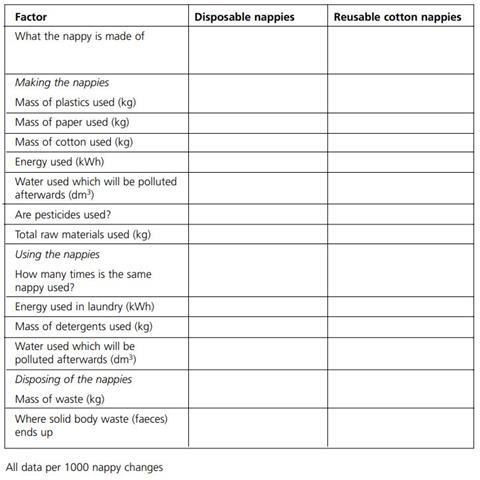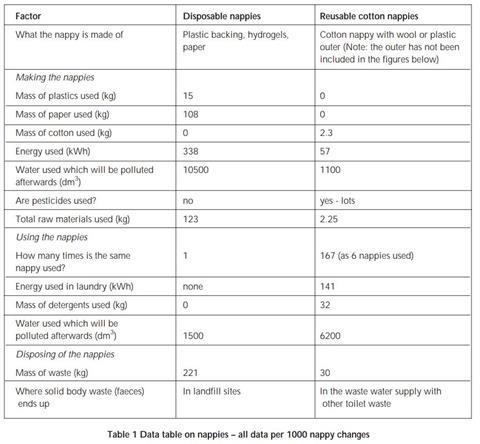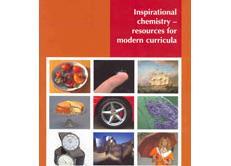There’s nothing better than a fresh nappy in the morning.
In this activity students put themselves in the position of a nursery/day care centre manager with the responsibility of choosing the type of nappy to be used on the children in their care. The activity is based on the idea of ‘life cycle assessment,’ which involves assessing the environmental impact of the production, use and disposal of a product. Students consider these three parts of the life cycle of a nappy and consider which has the least impact on the environment.
The work-based context helps interest and engage them. Students analyse information provided on a set of cards, find out about costs, come to a decision about which type of nappy they would use and then communicate what they have found out to their customers (the parents).
Running the activity
Give each student a worksheet and a table to complete and each pair or group a thoroughly shuffled pack of information cards. The cards could be laminated to protect them and make them easier to reuse. Alternatively, they could be copied onto cardboard. Much of the information on the cards is based on 1000 nappy changes. This is because it is hard to make direct comparisons between the two types of nappy without defining what is being compared in this way.
Students may need to have this explained to them. In the case of disposables, ‘1000 nappy changes’ refers to 1000 nappies; for reusables it refers to 1000 changes using a smaller number of nappies. Students could work in groups to complete the table. If you have internet access then they can look up current prices.
If internet access is difficult or time is limited you could provide them with the following information:
- On average, a disposable nappy costs 17.9p
- Babies require an average of six changes a day
- Over two years (average length of time a child is in nappies) the total cost of the disposable nappies required is about £700 based on the information above
- The total cost of 20 reusable nappies and waterproof pants is at least £60
- When washing costs are factored in, the cost of using reusables for two years is about £185
- The average price of a nappy laundering service is £8.50 per week.
- These figures are based on 2004 prices and information taken from the Women’s Environmental Network website.
Some basic questions are provided that could be used to help students make sense of what they have written in the table. The more able probably will not need them. The leaflet can be marked on the quality of the science it contains, as well as on presentation and persuasiveness.
Nappy facts
- In the first two years of its life a baby can use 5500 nappies
- 8 million nappies are thrown away every day in the UK.
- That means nearly 3 billion are thrown away every year.
- 90% of these nappies end up in landfill sites where they will stay mainly unchanged.
- It costs local authorities a lot of money each year to get rid of nappies (for example, Bristol City Council estimates it costs them about half a million pounds).
What options are available to people choosing nappies? What is the best solution for the environment? Suppose you are the manager of ‘The Green Nursery and Childcare Centre.’ You have made a commitment to your customers that your nursery will be the most environmentally friendly one in the area. You have bought wooden toys, you have a large garden for the children to play in and you have good quality, wholesome food for them to eat. Now you have to think about what type of nappies you will use for the children in your care.
You want to use a good, reliable product (you do not want leaking nappies on all those babies!) but you also want to make sure it is good for the children and for the environment. At the same time, you have to keep an eye on your profits. You need to find a solution that does not cost too much or you will not make any money.
There are two main options available to you:
- Disposable nappies
- Reusable cotton nappies.
If you use the reusable nappies you can either wash them yourself or get a nappy laundry service company to do it for you. To decide which product is best for the environment you need to do a ‘life cycle analysis.’ The analysis involves looking at how the nappies are made, used and disposed of and considering how these processes affect the environment.
When you have decided which type of nappy to use, you will need to produce a leaflet to explain your choice to the parents of the children at your nursery. Use the information cards to help you complete the data table and compare the two options. Most of the information on the cards is for 1000 nappy changes – this is not the same as 1000 nappies. Find out about the costs associated with each type of nappy.
For the reusable nappies, compare the cost of washing them at the nursery with using a nappy laundry service. If you decide you want to wash them yourself, you will probably need to employ another member of staff at least part time to do the laundry.
Put this in context
Find out how senior scientist, Phillip leads a team of researchers who look to improve the performance of household products such as toothpaste and nappies.
Questions
- Which of the nappy options uses less raw materials?
- Which causes more water pollution from pesticides and other pollution?
- Which produces a smaller amount of solid waste?
- Which do you think causes less harm to the environment?
- About 85% of parents in the UK use disposable nappies. Why do you think this percentage is so high?

Answers
- 1. Reusable nappies use less raw materials.
- 2. The reusables cause more water pollution – from pesticide use and from the laundry.
- 3. The reusables produce less solid waste.
- 4. This is a fairly subjective question – students are likely to answer that the reusable nappies cause less harm. This is probably true but the answer is not entirely clearcut.
- 5. Many parents use disposables because they are so convenient. Also, parents are often unaware of the environmental problems such nappies cause.

Downloads
Nappy choice
PDF, Size 0.64 mb
Additional information
This resource is a part of our Inspirational chemistry collection.
Inspirational chemistry book

A collection of resources, aligned with GCSE bodies, to support learners in England, Wales, and N Ireland.
- 1
- 2
- 3
- 4
- 5
- 6
- 7
- 8
- 9
- 10
- 11
- 12
- 13
- 14
- 15
- 16
- 17
- 18
- 19
- 20
- 21
- 22
- 23
- 24
- 25
- 26
- 27
- 28
 Currently
reading
Currently
reading
Nappy choice and the environment
- 30
- 31
- 32
- 33
- 34
- 35























































































No comments yet